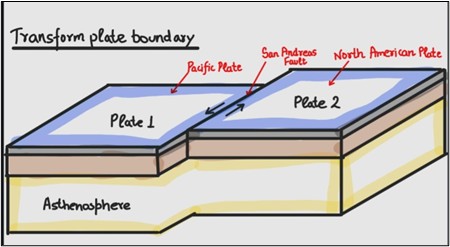Core Demand of the Question
- Changes in Shape and Sizes of Continents
- Changes in Shape and Sizes of Ocean Basins
|
Introduction
Continents and oceans owe their present configuration to the dynamic processes of plate tectonics. Divergent, convergent, and transform movements of crustal masses continuously reshape Earth’s land–ocean balance.
Body
Changes in Shape and Sizes of Continents
- Divergent Boundaries (Rifting and Continental Break-up): When continental crust is pulled apart, rift valleys develop, which eventually split landmasses. This leads to fragmentation and change in continental outlines.
- Eg: The East African Rift may split Africa into two separate continental blocks.

![]()
![]()
- Convergent Boundaries (Collision and Mountain Building): When two continental plates collide, intervening seas close, and the crust folds and uplifts into mountains. This reshapes continents by enlarging landmass thickness.
- Eg: The collision of the Indian and Eurasian plates formed the Himalayas and Tibetan Plateau.

![]()
![]()
- Transform Boundaries (Lateral Displacements): Strike-slip or transverse movements shift landmasses sideways, displacing continental margins and coastlines.
- Eg: San Andreas Fault, a transform boundary, causes horizontal displacement, shifting California along the Pacific Plate margin.

![]()
![]()
- Isostatic Adjustments (Vertical Re-shaping): Removal or addition of weight (erosion, ice melt, sediment load) causes crust to rise or sink, changing continental relief.
- Eg: Post-glacial rebound in Scandinavia has uplifted land, altering coastal shapes.
![]()
![]()
Changes in Shape and Sizes of Ocean Basins
- Divergent Boundaries (Sea-Floor Spreading and Basin Expansion): Magma upwells at mid-ocean ridges, creating new crust and widening ocean basins.
- Eg: The Mid-Atlantic Ridge is pushing the Americas and Africa–Europe apart, expanding the Atlantic Ocean.
- Ocean-ocean Convergent Boundaries (Subduction and Basin Shrinkage): Oceanic crust descends into trenches at subduction zones, reducing basin area and volume.
- Eg: The Pacific Ocean is shrinking along the Mariana Trench and Peru–Chile Trench.
- Continent-continent Convergent Boundaries: Convergence closes off ocean basins entirely as continents collide.
- Eg: The Tethys Sea disappeared when India collided with Eurasia.
- Transform Boundaries (Offsetting and Basin Reshaping): Oceanic transform faults laterally displace ridges and trenches, altering basin geometry.
- Eg: Fracture zones in the Atlantic offset the Mid-Atlantic Ridge segments.
- Divergent to Ocean Formation (Continental Rift to Ocean): Initial continental rifting can evolve into new ocean basins when seawater invades the rift.
- Eg: The Red Sea Rift is an embryonic ocean basin forming between Africa and Arabia.
Conclusion
Plate tectonics offers the most comprehensive explanation for the continuous changes in the shapes and sizes of continents and ocean basins. Though not fully precise in predicting every detail, it remains the most accepted and trusted framework to understand the dynamic nature of Earth’s crust.


